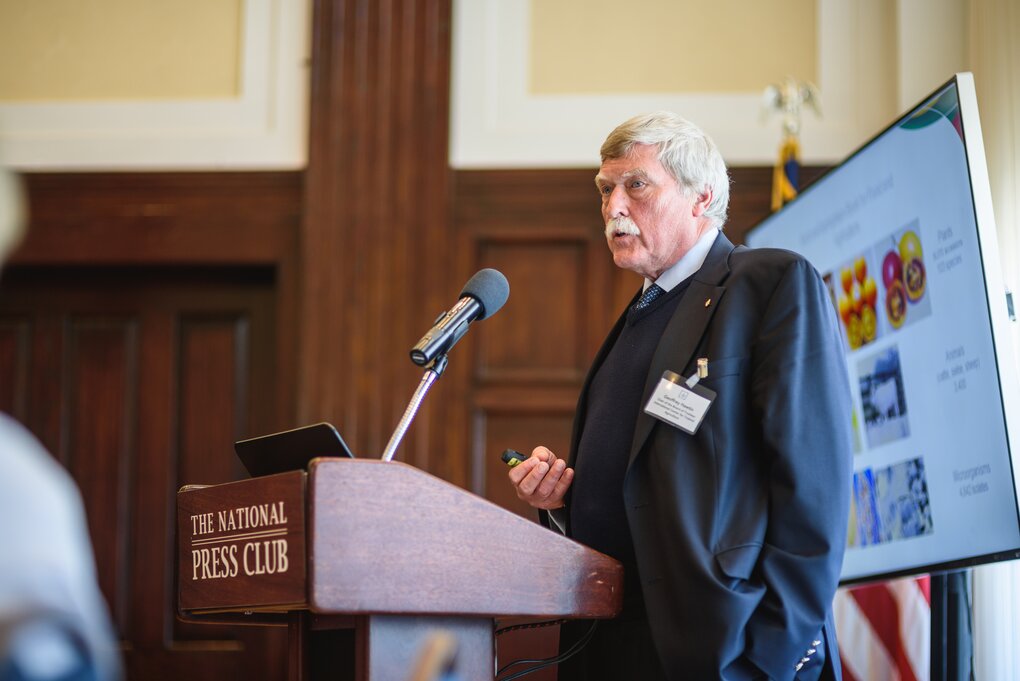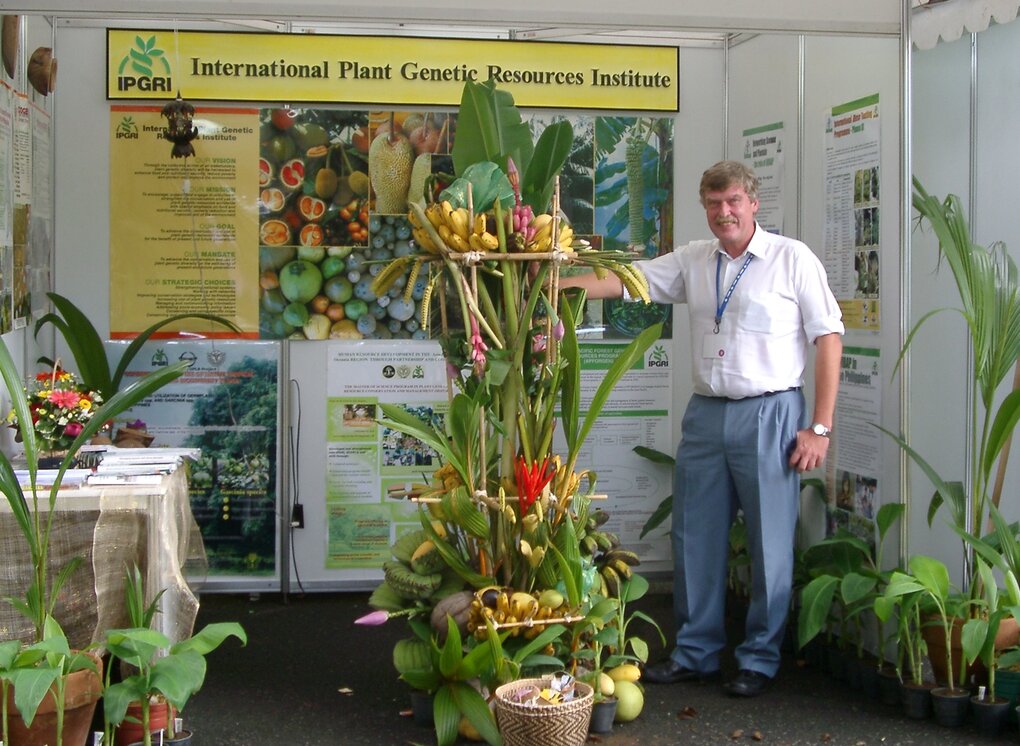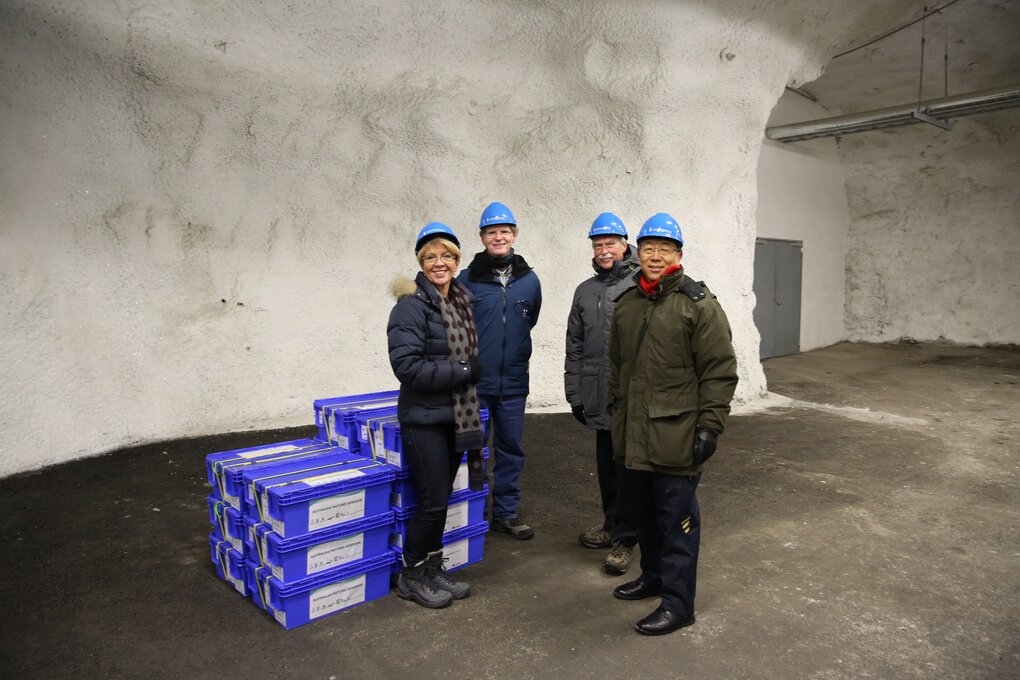Geoffrey Hawtin: Crop Diversity Pioneer Who Won the World Food Prize

7 October 2024
In this instalment of our Seed Heroes series, we celebrate the work of Geoffrey Hawtin OBE, a co-recipient of the 2024 World Food Prize, who believes that agricultural biodiversity is a significant part of the solution to the most significant challenges we face today. He is also the man behind one of the most recognizable moustaches in the plant genetic resources world.
Few people have done more for the cause of plant genetic resources over the past 40 years than Geoffrey Hawtin.
The British-Canadian plant geneticist – who served as the Crop Trust’s first Executive Secretary in 2004 – is among the most prominent figures in the modern-day history of crop diversity conservation. His dedication to food security was ultimately recognized when he was named as one of two laureates of the 2024 World Food Prize. He shares the honor with his long-time colleague Cary Fowler, both known for their pivotal roles in the creation of the Svalbard Global Seed Vault, the ultimate backup facility for crop diversity.
On 9 May 2024, the foundation that confers the award named Hawtin and Fowler as this year’s laureates in recognition of “their extraordinary leadership in preserving and protecting the world’s heritage of crop biodiversity and mobilizing this critical resource to defend against threats to global food security.”
Before the Seed Vault opened in 2008 on the Norwegian island of Spitsbergen in the remote Arctic Svalbard archipelago, Hawtin was a member of the committee that assessed the feasibility of the proposed facility. He also helped develop the technical, management and policy specifications for the Seed Vault, which were used by the Norwegian government in its construction and operation.
But let’s go back to the beginning. Hawtin’s long career started with the Arid Land Agricultural Development (ALAD) program, under which he led teams in Afghanistan, Ethiopia, Jordan, Lebanon, Syria and Turkey to collect local varieties of lentils, chickpeas and other legumes. At the outbreak of the Lebanese Civil War in the 1970s, Hawtin was a young postdoctoral scholar. He drove down a mined road to the Syrian border to find a safe place for a precious collection of legume seeds. Little did they know that they would have to make the journey three more times before he and his team were finally allowed to enter Syria and get themselves and the seeds to safety.

Geoffrey Hawtin at the Crop Trust International Pledging Conference in April, 2016.
The ICARDA Years
When ALAD’s legume improvement work was transferred to the International Center for Agricultural Research in the Dry Areas (ICARDA) in 1977, Hawtin went with it. He served as the first leader of the Food Legume Improvement Program at ICARDA’s Tel Hadya research station in northern Syria, just outside Aleppo.
He went on to lead numerous other initiatives at ICARDA, including the Nile Valley Project, which focused on increasing faba bean production. Eventually, he was appointed ICARDA’s Deputy Director General for International Cooperation, a reflection of the skills he had shown in bringing together diverse groups to work for a common cause.
Laying the Foundations for the International Plant Treaty
Hawtin left ICARDA to join the International Development Research Centre (IDRC) in Canada as Director of the Agriculture, Food and Nutrition Sciences Division. At IDRC, he played key roles in furthering the cause of crop diversity conservation. He was a member of the steering committee of the Keystone International Dialogue Series on Plant Genetic Resources, which brought together participants from diverse and often conflicting parties. These included non-governmental organizations, seed and biotechnology multinationals, national genebanks, CGIAR Centers, the UN system and many others with a stake in the future of plant genetic resources. Starting in 1988, this three-year series of meetings and workshops laid much of the groundwork for the development of the International Treaty on Plant Genetic Resources for Food and Agriculture (the International Plant Treaty).
Hawtin went on to join the management committee of the Crucible Project, which brought together the full spectrum of views on how intellectual property – patents and the like – can apply to plant genetic resources. The Crucible Group included people who were opposed to all forms of intellectual property protection over life forms, others who were exponents of the social benefits of intellectual property, and every shade of opinion in between. At first it seemed that they were never going to reach consensus on anything. But the group was in the end able to agree on 28 recommendations, a remarkable achievement.
Their final report – "People, Plants, and Patents: The impact of intellectual property on biodiversity, conservation, trade, and rural society” (IDRC, 1994) – aimed to “assist policymakers and opinion makers in an extraordinarily important, fast-changing, and politicized field to identify the major points and the range of policy alternatives that can reasonably be pursued.” It made a major contribution to the subsequent discussions and negotiations that led to the International Plant Treaty.
“The informal and off-the-record style of the meetings helped dissolve many encrusted views and personal antagonisms which had built up over the years,” said Fowler, according to the working paper “Negotiating the Seed Treaty” (2007). “The trust and, indeed, friendships which grew out of the meetings facilitated some rather remarkable policy breakthroughs.”

Geoffrey Hawtin at the Rio the Janeiro Conference/Earth Summit in June, 1992.
Return to the CGIAR
In 1991, Hawtin returned to the CGIAR, taking up the post of Director General of the International Board for Plant Genetic Resources, which became the International Plant Genetic Resources Institute (IPGRI) under his leadership. IPGRI saw many changes during his tenure (1991‒2003), including its administrative separation from the Food and Agriculture Organization of the United Nations (FAO) in 1994. IPGRI later became Biodiversity International and is now part of The Alliance of Bioversity International and the International Center for Tropical Agriculture (CIAT), an alliance of which Hawtin was a key architect.
This period also saw the initiation of new programs, including on in situ and on-farm conservation, neglected and underutilized species, crop wild relatives, socio-economics and Indigenous knowledge, and forest and tree genetic resources. This was an exciting time in the plant genetic resources sector. IPGRI and FAO developed a close partnership and IPGRI also forged links with NGOs and other civil society groups engaged in the debates on access to plant genetic resources, and the sharing of benefits arising from their use. The period also included the signing of so-called “in-trust agreements” that put the CGIAR crop diversity collections under the auspices of FAO.
Under Hawtin’s leadership, IPGRI also provided crucial technical inputs to the first “State of the World Report on Plant Genetic Resources for Food and Agriculture” and its associated Global Plan of Action.

Geoffrey Hawtin at the CGIAR AGM in the Philippines, 2002.
The Global Crop Diversity Trust
Despite the progress, it was clear to Hawtin that funding plant genetic resources conservation work faced an ongoing challenge. A large part of the reason for this is the inherent conflict between the short-term nature of funding for development work and the long-term view needed for conserving plant diversity. IPGRI therefore developed a proposal for an endowment fund to provide much-needed long-term, predictable funding. Following the endorsement of the CGIAR Finance Committee in early 2000, IPGRI held consultations with FAO, various member states of the Organisation for Economic Co-operation and Development, developing countries, the Global Forum on Agricultural Research and Innovation, and a number of NGOs. Together they explored the idea of establishing such a funding mechanism.
This ultimately led to the establishment of the Global Crop Diversity Trust (Crop Trust) and its Endowment Fund in 2004, with Hawtin as the new organization’s interim Executive Secretary.
Hawtin called setting up the Crop Trust as one of his proudest achievements. “It arose from genebanks that were experiencing financial difficulties and clearly needed some long-term funding support. It means we can give them funding if they are unable to pay for their electricity so all the crops are not destroyed. I’m hoping this award will bring attention to the issue, the endowment is at USD $300 million and [we’re] hoping to get [it] up to USD $500 million to get us to the next level of security. For the world to have complete security for all significant crops we need USD $800 million. If you think about it, USD $800 million is not a huge amount of money,” he shared in a recent interview.
Hawtin currently serves as a Member of the Crop Trust’s Executive Board.

Geoffrey Hawtin next to Cary Fowler, Marie Haga and Dr. Ren Wang at the Svalbard Global Seed Vault in February, 2024.
Moving On
Not one to rest on his laurels, Hawtin subsequently went on to lead the International Center for Tropical Agriculture (CIAT) in Colombia. He chaired the board of directors of the Tropical Agricultural Research and Higher Education Center (CATIE) in Costa Rica and served as a member of the board of trustees of the Royal Botanic Gardens in Kew, UK.
Hawtin’s contribution to the field of plant genetic resources has been widely recognized. In 1996, he was elected correspondant étranger (foreign correspondent) of the Académie d’Agriculture de France. In 2005, he was awarded the Frank Meyer Medal for Plant Genetic Resources by the Crop Science Society of America, and in 2017 he was made an Officer of the Order of the British Empire (OBE) for “services to global agrobiodiversity conservation, subsistence livelihood enhancement, and sustainable food programmes”.
If anyone deserves the honor of Seed Hero, it is Geoffrey Hawtin.
Timeline
- 1970: Graduated with MA in 1970 from the University of Cambridge
- 1974: Graduated with PhD from the University of Cambridge following research on genetic variation in soybean at Makerere University in Uganda
- 1974: Joined ALAD as legume breeder, based in Lebanon and Egypt
- 1976: Appointed leader of the Food Legume Improvement Programme, ICARDA
- 1981: Appointed Deputy Director General, International Cooperation at ICARDA
- 1985: Joined IDRC as Director of the Crops and Animal Production Systems Programme
- 1988: Appointed Director, Agriculture, Food and Nutrition Sciences Division, IDRC
- 1991: Appointed Director General, International Board for Plant Genetic Resources (subsequently IPGRI)
- 2003-2005: Interim Executive Director, Global Crop Diversity Trust (Crop Trust)
- 2008: Appointed interim Director General, CIAT
- 2005: Awarded the Frank Meyer Medal for Plant Genetic Resources by the Crop Science Society of America
- 2006-12: Member and Chair, Board of Directors, CATIE
- 2005-2022: Advisor, Global Crop Diversity Trust
- 2009-15: Member, Board of Trustees, Royal Botanical Gardens, Kew
- 2011-2019 Member and Chair of the Board of Trustees of CIAT and Co-chair of the Board of the Alliance of Bioversity and CIAT, 2018-2019
- 2012-17: Senior Technical Advisor, International Treaty on Plant Genetic Resources for Food and Agriculture
- 2017: Appointed Officer of the Order of the British Empire (OBE)
- 2023: Member of the Executive Board of the Crop Trust
- 2024: Co-recipient of the World Food Prize, shared with Cary Fowler
Categories: For Educators, For The Press, For Partners, For Students


